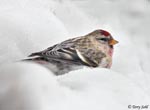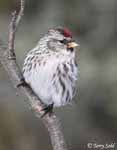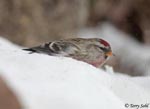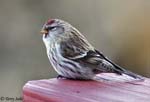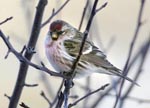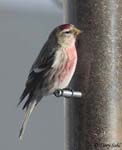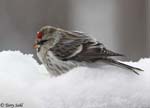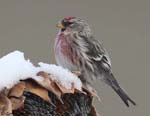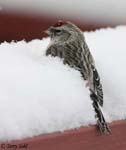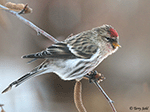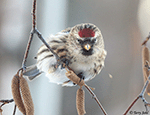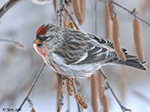Common Redpoll
Carduelis flammea
| Length: 5.25 inches | Wingspan: 8.25 inches | Seasonality: Winter / Migrant |
| ID Keys: Red cap, black chin patch, short stubby bill, pink wash on chest (male), dark brown streaks on sides | ||
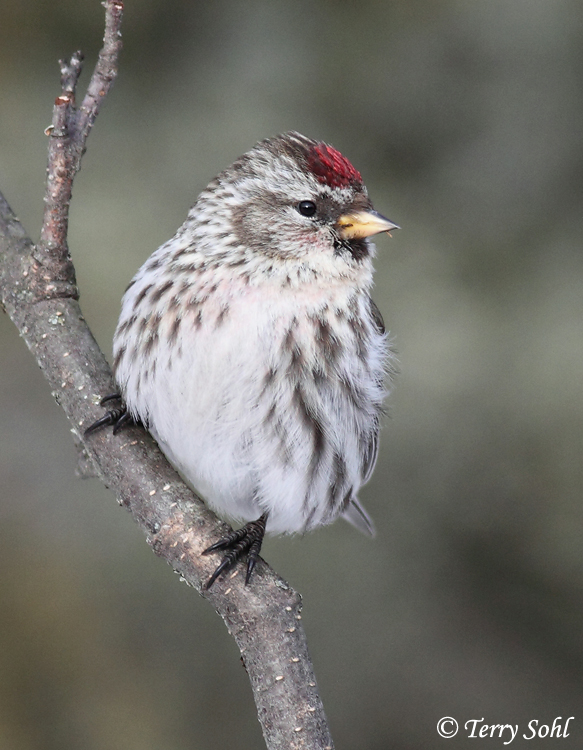 The
Common Redpoll breeds in the Arctic, but is an irregular winter migrant to
southern Canada and the northern United States. They are well adapted to
cold climates, even having a small pouch in their throat where they can store
food, allowing them to dart out into the cold and collect a large amount of
food, and then return to a protected perch to slowly ingest it. They will
often visit bird feeders, where they are often extremely tame.
The
Common Redpoll breeds in the Arctic, but is an irregular winter migrant to
southern Canada and the northern United States. They are well adapted to
cold climates, even having a small pouch in their throat where they can store
food, allowing them to dart out into the cold and collect a large amount of
food, and then return to a protected perch to slowly ingest it. They will
often visit bird feeders, where they are often extremely tame.
There is some question as to the species status of Common Redpolls and their close cousins the Hoary Redpoll. Hoary Redpolls do have distinct differences from Common Redpolls, with a tiny, stubby bill, much paler coloring overall, and far less streaking. But there are intergrades between species, and recent genetic analysis has found only very small differences, indicating they may be better treated as one species.
Habitat:
Uses brushy areas for breeding, such as forest clearings, forest edges, thickets of dwarf birch or willow, and shrubby areas on the tundra. Can be found in a variety of semi-open habitats during the winter.
Diet:
Primarily feeds on seeds. Also will take buds, catkins, and insects. In our yard in winter, when they do visit, they are attracted more to the catkins on our paper birch than they are to even the feeder complex with niger and sunflower seed.
Behavior:
Forages at all levels vegetation and also on the ground. Gregarious, usually foraging in flocks outside of the nesting season.
Breeding Map:
Non-breeder in South Dakota. The nest of a Common Redpoll is a cup of grasses, small twigs, mosses, and feathers. The female usually lays 4 or 5 eggs, and she does all of the incubating. When the eggs hatch, the female does most of the feeding of the young. The young fledge after about 2 weeks.
Common Redpoll Song / Calls:
A trilling followed by a bubbly twittering that may go on for some time. The calls of a Common Redpoll include a trilling, a repetitive series of sweet chee-chee-chee notes, or a nasal call rising in pitch.
- Click here to hear the nasal call of a Common Redpoll1
- Click here to hear the repetitive chee-chee-chee-chee call of a Common Redpoll2
- Click here to hear the mixed calls of a group of Common Redpolls at a feeder complex3
- Click here to hear the complex song of a Common Redpoll4
Migration:
Summers in northern Canada and Alaska up through the Arctic Circle. In winter, they are very irregular migrants, moving only short distances southward during some winters, and moving well into the continental United States in other winters.
Interactive eBird Map:
Click here to access an interactive eBird map of Common Redpoll sightings
Similar Species:
Common Redpolls are one of several small finch species with streaking on their underparts that are found in South Dakota (some just during the winter months). Here are species most likely to be confused with a Common Redpoll:
- Hoary Redpoll - The first question...is Hoary Redpoll even a distinct species (see notes above). Hoary Redpolls are typically few and far between in the lower 48 states, even during heavy winter irruptions. In terms of appearance, they are much paler overall, and have a very small bill that is noticeably shorter than Common Redpolls. They also tend to have far less striping on their flanks than do Common Redpolls.
- House Finch - House Finch are typically the most common of these species at feeders in South Dakota. They are larger than Common Redpolls (although size can be difficult to judge if the two species aren't seen side-by-side). They also have a heavier, dark bill, compared to the small, yellowish-orange bill of a Common Redpoll. The red on a male House Finch is much more extensive than that of a Common Redpoll, found on the head and breast. Female House Finch lack any red and have heavier streaking, more consistent streaking across their underparts than do Common Redpolls.
- Purple Finch - Purple Finch can be differentiated from Common Redpolls by most of the same characteristics noted for House Finch above. Note the reddish color on a Purple Finch male is even more extensive than that of a male House Finch.
- Pine Siskin - Pine Siskins can sometimes be surprisingly difficult to differentiate from Common Redpolls at times, particularly for birds at some distance. Both are quite small with streaking, and at distance, it can be difficult to see the red crown patch on Common Redpoll. Pine Siskins also have yellow edging on their wings, but given plumage variations and the position of a bird, that yellow sometimes isn't obvious in the field.
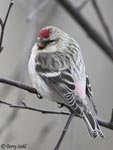 |
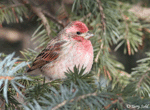 |
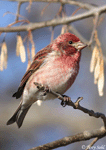 |
 |
| Hoary Redpoll | House Finch | Purple Finch | Pine Siskin |
Conservation Status:
Systematic surveys in North America have shown rather substantial declines in Common Redpoll populations over the last few decades. Population trends are more mixed in the European part of their range, where numbers appear to be more or less stable. Reasons for the North American decline aren't clear, but are likely a combination of habitat loss and climate change. Overall, however, Common Redpolls are found across a very broad geographic range and are common in parts of that range. The IUCN lists the Common Redpoll as a species of "Least Concern".
Bird Feeders:
Will come to feeders for sunflower seeds, millet, and niger ("thistle") seed (with the latter typically being their favorite for their visits in my yard). Note the biggest attractant of Common Redpolls in my yard hasn't been the bird feeders, but the catkins on a large Paper Birch in our landscaping. The catkins also attract other finches all winter long (House Finches, American Goldfinches, Pine Siskins).
Further Information:
Photo Information:
December 2004 - Sax-Zim Bog in northern Minnesota - Terry Sohl
Additional Photos:
Click on the image chips or text links below for additional, higher-resolution Common Redpoll photos.
Audio File Credits:
- 1Paul Marvin. Recorded in Lake County, Minnesota on November 2nd, 2014. Original recording and information available from xeno-canto.
- 2Steve Hampton. Recorded in Matanuska-Susitna, Alaska on May 26th, 2017. Original recording and information available from xeno-canto.
- 3Lance A.M. Benner. Recorded in the Yukon Territory of Canada on March 17th, 2018. Original recording and information available from xeno-canto.
- 4LAndrew Spencer. Recorded in the Nome Census Area of Alaska on June 5th, 2013. Original recording and information available from xeno-canto.
| Click on the map below for a higher-resolution view |
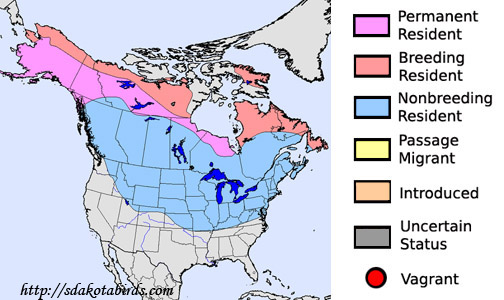 |
| South Dakota Status: Irregular winter visitor, most common in the northern part of the state. |
Additional Common Redpoll Photos
Click for a higher-resolution version of these photos
